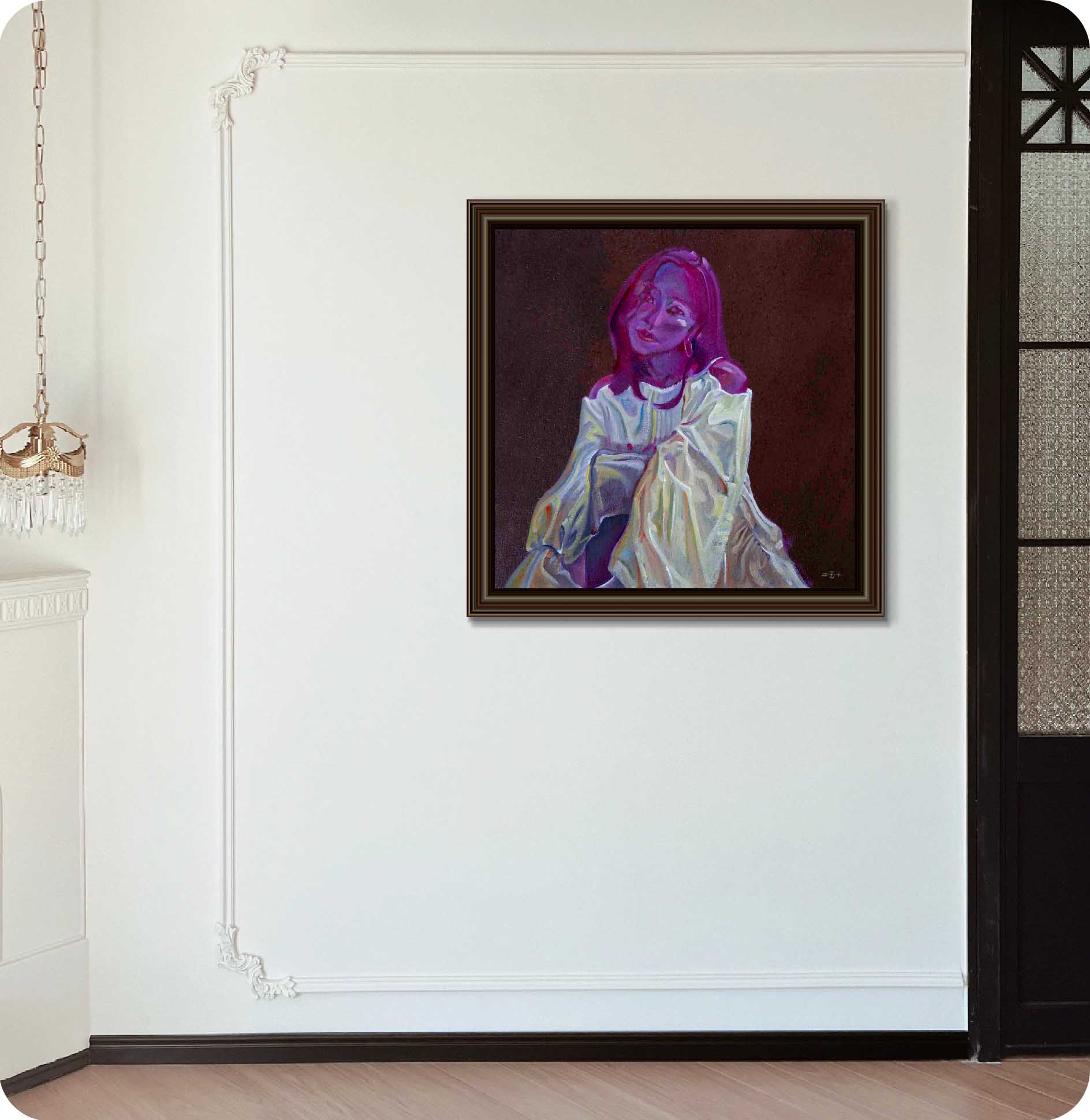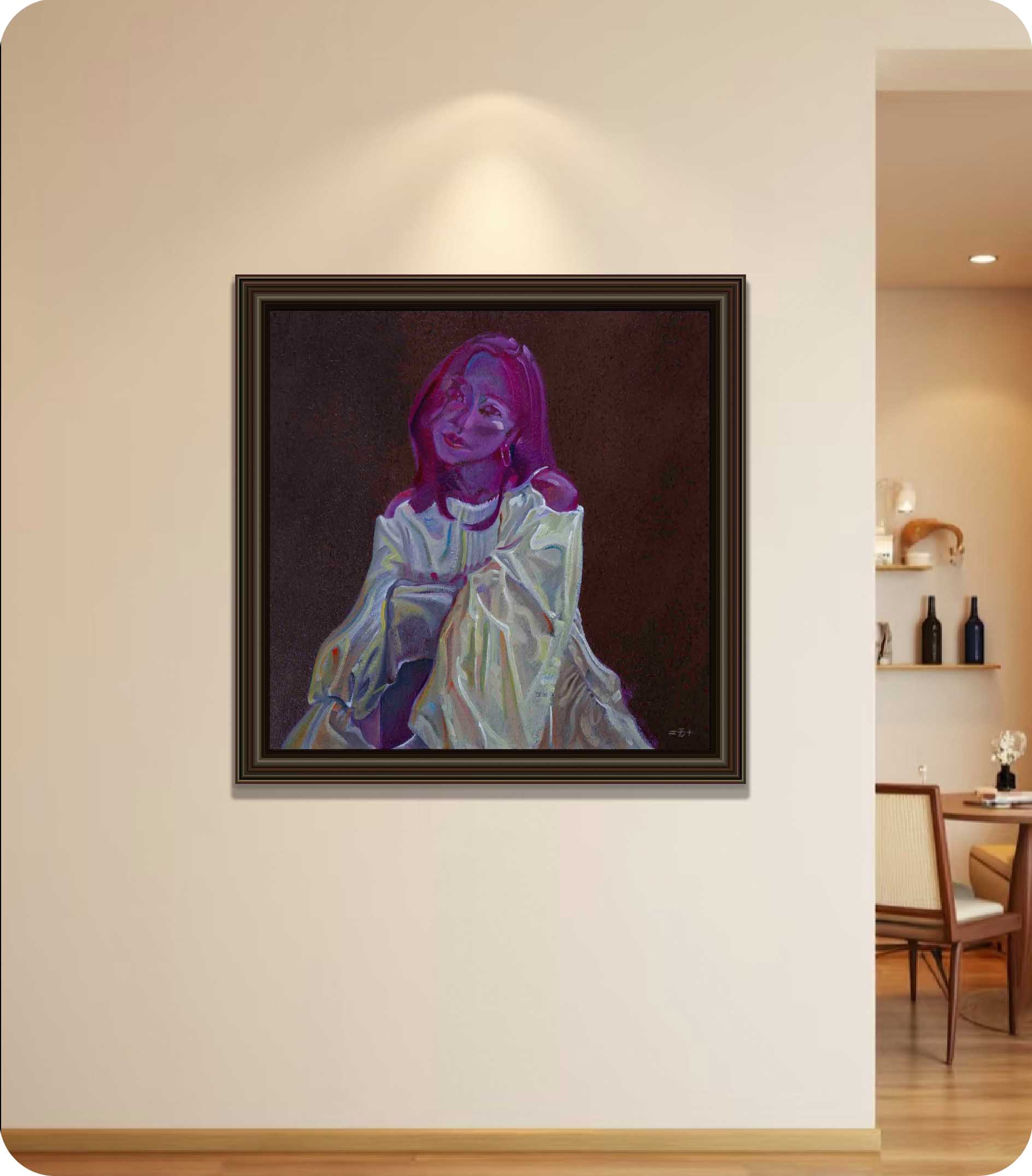The theme of this year's painting clearly states one - the makeup of desire. People's various desires are wrapped under various makeups. Desires are the intertwining of happiness and pain in life. Either straightforward or subtle, they will appear in makeup, forming a profound look of an era.
Inches: 15.7 x 15.7 in
Size without the frame: 40 x 40 cm
Country: China
Date: 2025
Materials: Oil paint on board
Condition: well preserved
Creative themes and style | My works revolve around the creative concept of "The land of humanity, People on the land".The people in the painting are people in nature, and the lines, shapes, and colors are close to nature. The nature in the painting is nature in the eyes of humans, existing in interaction with humans.I don’t pursue a series of works with a fixed and continuous style. I hope that the style of the pictures will synchronize with the changes in my life and always remain oscillating. The performance of the work must be in sync with the development of one's own life in order to be Sincere and powerful.Ideas are later.
An Interview with Artist Philo by Artphiloso Gallery
If you would like to collect this artwork or know more about the artist, please contact us.


Rebellion Against Traditional Portraiture
Defined as a portrait, this painting quietly resists convention. It does not fix identity through facial likeness, social markers, or psychological realism. Instead, the figure is disassembled by color and light, reducing the human subject to a visual equation of form, hue, and rhythm. Unlike Albrecht Dürer’s Self-Portrait, which affirms individuality, this work strips away identity, inviting viewers to decipher the subject as a composite of chromatic structures rather than a singular personality.
Fluid Form and Organic Vitality
The figure’s boundaries dissolve: hair merges into shoulders, fabric folds into skin, all rendered as pulsating zones of color. This recalls Jean Arp’s exploration of organic forms, though where Arp abstracted, this painting injects organic vitality into a figurative body. The figure ceases to exist as a static container of flesh and instead emerges as a living organism of color, constantly shifting with its own inner pulse.
The Background as Dark Matter
The deep brown background absorbs light like a gravitational field, exerting pull on the vibrant purples, yellows, and blues of the figure. Yet the figure resists, glowing with a luminous counterforce. This interplay is less about classical balance than about cosmic dynamics: attraction, resistance, and suspension. The result is a force-field composition, where the viewer’s gaze oscillates between darkness and radiance, between dissolution and endurance.
Color as Emotional Chemistry
Here, color is not decorative but chemical—a laboratory of emotion. Purple hair fuses melancholy with mystery; the garment’s scattered hues of blue, yellow, and red embody intensity and disorientation; the dark brown background catalyzes depth and the unknown. This recalls Josef Albers’ experiments in Homage to the Square, yet where Albers sought clarity through pure color interaction, this painting throws hues into an emotional reactor. Each tone becomes a formula of psychic energy, colliding and recombining to generate unique emotional matter.
Concept of the Blazing Sun
The title “At the Edge of the Blazing Sun” frames the work as a solar experiment. The blazing sun represents an extreme condition of exposure—a metaphorical light source that reveals hidden structures by forcing them toward decay. The purple shadows in the face, the fading iridescence of the garment, and the consuming brown void are all traces of reaction under this burning light. The canvas reads like a field report of psychic weathering, documenting how form and identity erode when placed under extreme illumination.
Shang Yang, Grand Portrait
Shang Yang deconstructs portraiture through collage and fragmented features, paralleling this painting’s anti-portrait strategy. Both works treat the human figure not as a fixed likeness but as an experimental field of visual elements.
Francis Bacon, Screaming Pope
Bacon dismantles traditional portraiture with distortion and chromatic violence. While Bacon tears at flesh and form, this painting conducts a subtler dismantling through color chemistry. Both works, however, reject the “perfect portrait” to unearth deeper visual truths of instability and fracture.
The hair uses a magenta base tone, with subtle hints of blue in the highlights. This was done to achieve an effect where it blends into the background colors while still maintaining a slight distinction.
The character wears loose, colorful, off-the-shoulder garments. The color palette is rich, and the brushstrokes are intentionally crisp and defined to enhance the visual texture.
The background is a deep brown and relatively minimalist. The texture features a unique granular effect, created by applying acrylic paint with a roller.
The skin tone is a cold color palette mixed from the hair color. This creates a cohesive tonal relationship with the hair while achieving a glass-like clarity and translucent quality.
A: Click here to view ARTPHILOSO's Guide for Collectors.
More paintings from this series:
End of the Blazing Sun 1 End of the Blazing Sun 2
End of the Blazing Sun 3 End of the Blazing Sun 4
End of the Blazing Sun 7 End of the Blazing Sun 8
End of the Blazing Sun 9 End of the Blazing Sun 10
